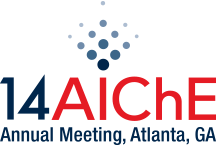

Design and performance of a novel reverse-flow fixed-bed reactor for chemical-looping combustion
Lu Han, Zhiquan Zhou, George M. Bollas
Abstract
The reactor technologies for chemical-looping combustion (CLC) are categorized as circulating fluidized bed reactors, rotating reactors, and alternating flow reactors (Fig. 1). The most widely used reactor type is based on the interconnected fluidized-bed design, which has been successfully demonstrated in pilot plants built in Chalmers University of Technology (Sweden), Institute of Carboquimica (Spain), Korean Institute of Energy Research, and Vienna University of Technology to name a few. Fluidization promotes excellent contact between the gas and solids, which enables the process to achieve both high fuel conversion and CO2 selectivity, in addition to a uniform temperature distribution, small pressure drop, and continuous operation. However, circulation of the solids requires an energy-intensive cyclone system and loop seals to prevent air/fuel slip. This harsh process makes particle attrition inevitable and creates fines that can be entrained out of the fluidization vessel. These issues can severely impact the process economics and safety of the CLC process, for example, if Ni is used as the oxygen carrier. Alternatively, CLC can be implemented in a transiently operated fixed-bed reactor where the gas flows alternate between reducing and oxidizing environments. This design eliminates the need for gas-solid separation and relieves some of the requirements of a potential oxygen carrier. Fixed-bed reactors are in general easier to operate, scale-up and pressurize and are flexible to handle a range of particle sizes. The design is also more compact than a fluidized-bed reactor, which allows for better utilization of the oxygen carrier, lower capital cost, and smaller process footprint. However, the performance of the fixed-bed process exhibits lower CO2 selectivity, greater carbon deposition, and much higher temperature fluctuations compared to an equivalently designed fluidized bed reactor. Other proposed reactor options for CLC include the moving bed reactor, rotating reactor, and rotary reactor. These designs share in the technical difficulties that arise from putting solids in motion, specifically related to gas leakage and product gas mixing with air.

Figure 1. Reactor options for CLC: (a) circulating fluidized-bed; (b) rotating reactor; and (c) alternating flow over a fixed-bed.
In this paper, a novel reverse-flow reactor is proposed for CLC of gaseous fuels, that integrates gas-solid separation, reaction, and heat transfer in a single fixed-bed unit. The periodic reversal of the fuel gas during the oxygen carrier reduction cycle promotes more uniform contact between the fuel and the unconverted solids and better utilization of the conductive heat of the packed bed, while maintaining the intrinsic advantages of a stationary bed. Reverse-flow reactors had been traditionally employed as a method to improve the heat integration for many industrially relevant reactions, including SO2 oxidation, total oxidation of hydrocarbons in off-gases, and NOx reduction. When applied to CLC of gaseous fuels, the reverse-flow reactor achieves higher CO2 selectivity for all practical oxygen carrier conversions compared to a traditional fixed-bed process, at no expense of the fuel conversion. Frequently reversing the direction of the flow provides a uniform conversion profile inside the bed and yields an even higher CO2 selectivity. Observing the CO2 capture efficiency of the process (defined as time-integral of the CO2 product distribution over the total flow of fuel fed), the traditional one-directional reactor quickly drops below 90% at an overall bed conversion of 35% while the reverse-flow reactor can be continually operated till a conversion of 60% to meet the same efficiency. These results are comparable to a circulating fluidized bed unit, which achieves about 94% CO2 gas yield for a solid conversion of 60%. Additional benefits to the heat transfer characteristics are also realized with the reverse-flow design, where at least a 50℃ reduction in temperature drop is exhibited. The results of this work demonstrate that periodic reversal of the gas flow during CLC reduction leads to significant improvements in reactor performance, in terms of CO2 selectivity, CO2 capture efficiency, and bed temperature fluctuations. This fixed-bed design avoids the issue of attrition and gas-solid separation commonly found in circulating fluidized-bed units. Furthermore, the simplicity of the process makes it easily applicable to existing bench-scale units without considerably complicated equipment, for which scale-up does not entail significant challenges. Further design considerations and areas for optimization will be discussed.
Acknowledgement: This material is based upon work supported by the National Science Foundation under Grant No. 1054718.
